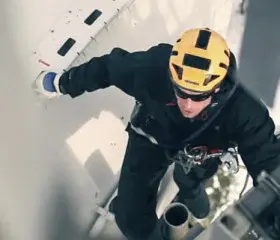/479216033-1600x400.jpg?width=300&name=479216033-1600x400.jpg)
IMPLEMENT AN EFFECTIVE PERMIT TO WORK SYSTEM
An effective Permit to Work system is easy to achieve when you understand and implement the corresponding processes.
Any non-routine task that can potentially affect people's health or safety should not be performed without a Permit to Work. However, if such tasks need to be performed regularly and frequently (e.g. by operators), they may not be subject to a Permit to Work, provided arrangements have been put in place to ensure they are consistently carried out in a safe manner (e.g. by means of detailed work instructions and thorough training).
Any tasks that require a Permit to Work should be documented in work instructions, including details for specific locations, departments, time of day, etc.
In addition, where required, a job safety analysis or equivalent should be prepared and used for hazardous activities. It is also important in circumstances where:
- There is no procedure for the activity; or
- It is not an activity that is routinely carried out; or
- There is a procedure, but a change of circumstances (e.g. using new plant, weather conditions, etc.) means the procedure is no longer sufficient.
Include an assessment of the potential risks associated with the activity along with any additional risks in the job safety analysis.
Persons who may issue Permits to Work should be properly trained in hazard identification, assessment and control.
All such persons should be authorised to complete Permits to Work and should be trained and competent. Records of such training and competency should also be maintained.
Potential Hazards
Before issuing a permit to work, the issuer should consider all potential hazards. This should include, but are not limited to, the following:
- Material hazards, such as Hazardous Substances and Dangerous Goods
- High pressure
- Temperature, including work in hot or cold locations
- Fumes
- Electrical hazards
- Mechanical energy
- Hazardous areas
- Height
- Radioactive substances
- Restricted space or vision
- Any other hazard, which may apply to a particular task, location, or time of day.
- Precautions
The permit to work should clearly specify the precautions and hazard control measures, which need to be employed. This may include:
- Physical isolation
- Electrical isolation
- Decontamination
- Precautions for working in confined spaces
- Precautions for hot work
- Precautions for working at heights
- Precautions for excavation work
- Precautions for work on High Voltage Equipment
- Precautions for abrasive blasting work
- Personal Protective Equipment (PPE) to be used
- Any other special precautions.
The Issuer should ensure that all Permits to Work are registered in the Permit to Work register.
Responsible managers should check the register at the end of each work period (day or shift) and resolve each Permit to Work that has not been closed.
The Issuer of the Permit to Work should ensure that the persons assigned to perform the work are qualified and properly trained.
All hazards and control measures should be explained to the persons assigned to the job prior to the commencement of the work. Subsequently, the workers must understand and use precautions and personal protective equipment.
When work is required to be carried out on plant or machinery, the Permit to Work system should ensure that:
- Appropriate people are authorised to carry out the designated work. This may be a specific type of work or any type of work in a specific area;
- The people carrying out the work are clear about the exact identity, nature and extent of the job and the hazards involved, including any specified limitations on the extent of the work and the time during which the job may be carried out;
- The precautions which need to be taken, including safe isolation from potential risks such as electricity and hazardous substances, have been specified;
- The person in direct charge of the plant or in charge of the area where the plant is located is aware of all the work being done under the Permit to Work system;
- A system of continuous control is in place;
- A record showing the nature of the work and the precautions needed which are checked by a competent person or people;
- The relevant permits are suitably displayed;
- A procedure for times when work has to be suspended in place and used;
- A cross-referencing of permits for work activities that may interact or affect one another is utilised;
- A formal handover procedure for use when the permit is issued for a period longer than one shift in place; and
- A formal hand back to operations procedure is in place to ensure that part of the plant affected by the work is in a safe condition and ready for reinstatement.
Once a Permit to Work has been issued, the work should be carried out as specified in the permit. At the completion of the job, the permit should be returned to the Issuer and closed.
This should be registered in the permit-to-work register, and all Permits to Work records should be kept for a period of 2 years.
Introducing a Comprehensive Permit to Work System for Enhanced Workplace Safety and Efficiency
Work Safety Hub understands the importance of a well-implemented Permit to Work system in ensuring a secure and efficient work environment. Our expert team is dedicated to providing your organisation with a structured and thorough approach to managing workplace risks.
We offer a detailed framework for:
Our all-encompassing methodology covers identifying potential hazards, establishing necessary precautions, and implementing hazard control measures for a wide array of tasks, from handling hazardous substances to operating high risk equipment.
With our Permit to Work system in place, your organisation will benefit from:
- A rigorous process to manage work on plant and machinery.
- Assurance that all required precautions are employed.
- Maintenance of continuous control over ongoing tasks.
Work Safety Hub will assist your organization in creating and maintaining a digital Permit to Work register, enabling you to efficiently track and resolve permits while preserving records for future reference and analysis.
By choosing Work Safety Hub, you invest in the enhancement of workplace safety and efficiency. Our team is committed to providing the necessary tools and guidance to seamlessly integrate a robust Permit to Work system into your organisation's operations.
A permit to work system is only as strong as the framework behind it.
We’ll help you integrate permits into a cohesive WHS Management System that ensures consistency, control, and compliance across your operations.Download Your Free Checklist PDF
Get instant access to our expert-designed checklist to help you. Simply fill out the form below to download your copy.SIMILAR READINGS

3 min read
3 min read
Falls from heights account for many injuries and fatalities...

2 min read
2 min read
Keep contractors and consultants safe on your work...
Read More
2 min read
2 min read
What are your obligations in regards to safety when it...
Read More
2 min read
2 min read
Ensure optimum safety for workers working on elevated...
Read More